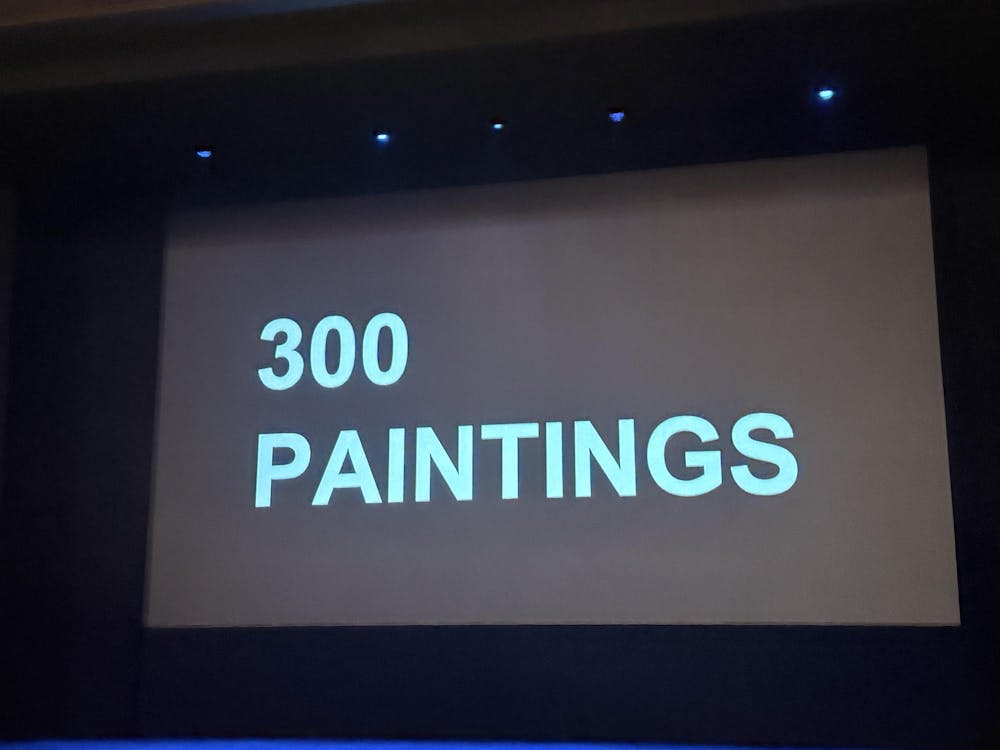After battling my way through torrential rain and violent wind on Oct. 30, I entered McCarter Theater for its new show, “300 Paintings.” Premiering at McCarter after a highly successful off-Broadway run, “300 Paintings” follows Australian comic and artist Sam Kissajukian’s creative and personal journey over a tumultuous six-month period in which he, living in a converted cake factory, created 300 paintings.
Still drenched from the rain, I entered the theater to a sea of senior audience members, most of whom were certainly regulars. Eventually, I found my seat beside a pair of sweetly bickering 60-year-old friends and a lovely couple in their 80s, sharing a bag of popcorn. Absorbing my surroundings, nothing stood out of the ordinary at first, with only the stage’s background projecting the show’s title in bold white lettering. But as the theater’s lights dimmed and a pre-recording of Kissajukian’s voice introduced himself, nothing could have prepared me for what came next.
For the first few minutes of the show, Kissajukian provided background for the forthcoming action-packed story the audience was about to experience. He shared how, in his mid-30s, after a life of pursuing stand-up comedy, he quit, feeling invisible and directionless. At one point, Kissajukian even expressed how he thought he had become a caricature of himself.
For Kissajukian, the loss of passion, coupled with witnessing his closest friends embark on new chapters of their lives through marriage and parenthood, triggered an identity crisis. Evicted from his apartment, Kissajukian then moved into an abandoned-cake-factory-turned-loft in Sydney, where, after serendipitously finding a beret in one of his moving boxes, he found inspiration to become an artist.
Starting seemingly as a gag and a way to spend time, Kissajukian began painting on cardboard boxes he found around the loft. Starting with comedic portraits of his friends, Kissajukian quickly began to delve deeper into the life of an artist, researching renowned painters and experimenting with modernist and fragmented Picasso-esque styles.
After briefly taking advice from a friend in art school, Kissajukian then embarked on an isolated, uninhibited, and absurd yet highly inventive six-month period in which he experimented in an exorbitant variety of styles from abstractionism to “miniature paintings” enclosed in terrariums to digital playable museums, and individually painted priceless World War II pennies. In this time, he experienced a prolonged manic and depressive episode, which later led to a bipolar disorder diagnosis.
While Kissajukian’s performance at McCarter began slowly, filled with a few occasional chuckles, as its story progressed and unraveled with an almost unbelievable absurdity — much like a snowball rolling down a hill — it soon transformed into a captivating ride where you were hanging on every word, laughter growing louder and louder.
Although I initially felt unconvinced by Kissajukian’s limited stage presence and sardonic wit, with his performance feeling more like a TED Talk than a comedy show, I quickly changed my mind. As the show advanced, the balance between his dry, sarcastic delivery and sheer ridiculousness of his stories proved to be a perfect combination for his return to standup.
From the moment Kissajukian’s story begins, almost every part seemed made-up. Yet the truth is that over six months, under a manic episode, Kissajukian produced 300 intimate paintings, forcing himself into lucid dreaming through a sleep schedule alternating between sleeping at midnight and noon. He also invented a ludicrous business plan based on the saying “when you lose you win and when you win you lose” that both landed him a meeting with real Wall Street investors and a $10,000 dollar investment he instantly declined. He secured a five-figure contract with one of America’s wealthiest businessmen — who remained unnamed — who financed him in a marketing pitch/performance art piece based on doing everything a business shouldn’t do titled “Pisscaso.” He knocked himself out for nearly 20 minutes in a pool of paint, was diagnosed with bipolar disorder by psychiatrists, and in the end became a successful professional artist with multiple feature galleries throughout the world.
Despite this rollercoaster of a story, Kissajukian grounded his material in profound honesty and a visceral sense of intimacy he built with his audience throughout the show. While advertised by McCarter and others as a “wildly original show,” I found Kissajukian’s comedic brilliance and inventiveness not in the show’s unique structure that included an art exhibit of his paintings post-medical diagnosis, but instead in his exceptional ability to interweave sincerity, absurdity, self-deprecation, and the highly intimate journey of artistry in an accessible manner.
In this way, the strongest elements of “300 Paintings” were not its humor, but rather its visceral feeling of humanity. Just like real life, Kissajukian’s story is not a shallow body of quick jokes, but an equally flawed and inspirational personal journey filled with humor, fear, anxiety, happiness, and self-discovery. It is this combination of witty satire with emotional honesty, confronting and reflecting on the nuances of life’s darkest moments, that elevates Kissajukian’s show to the next level.
While Kissajukian’s “300 Paintings” certainly lands multiple punches with several perfectly executed jokes, impressions, and stories to the delight of the audience, it is the show’s foundation of earnestness, embrace of one’s flaws, and mature self-reflection that distinguishes it above other stand-up performances.

Gavin McLoughlin, a member of the Class of 2028, is a head editor for The Prospect. He can be reached at gm9041@princeton.edu.
Please send any corrections to corrections[at]dailyprincetonian.com.








